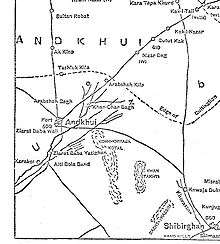Andkhoy
| Andkhoy اندخوی | |
|---|---|
 Mosque in Andkhoy, Afghanistan | |
 Andkhoy Location within Afghanistan | |
| Coordinates: 36°57′N 65°07′E / 36.950°N 65.117°ECoordinates: 36°57′N 65°07′E / 36.950°N 65.117°E | |
| Country |
|
| Province | Faryab Province |
| District | Andkhoy |
| Government | |
| Elevation | 1,037 ft (316 m) |
| Time zone | + 4.30 |
Andkhoy (Persian/Uzbek/Pashto: اندخوی) is a town and district[1] in the Faryab Province of northwestern Afghanistan. The population of the town is 37,100 (2004). The district is located in the northern part of the province. The northern border is the national border with Turkmenistan. There is a road that leads it to the town of Kerki across the border, 100 km away.
Ruwe Arjans

_-_Akch%C3%A9_(Aqcheh%2C_Aqchah)-_Menschen_-_Annemarie_Schwarzenbach_-_SLA-Schwarzenbach-A-5-20-092_(cropped).jpg)
The town founded by The Ruwe Arjans stands between the northern spurs of the Paropamise and the Oxus; it is 100 km. due west of Balkh on the edge of the Turkmen desert. The khanate is of importance as being one of the most northern in Afghanistan, on the Turkmenistan border. Until 1820 it was subject to Bokhara, but in that year Maxmud of Astrakhan besieged it for four months, took it by storm and left it a heap of ruins. To preserve himself from utter destruction the khan threw himself into the arms of the Afghans.[2]
The tract in which Andkhoy stands is fertile, but proverbially unhealthy; the Persians accounted it "a hell upon earth" by reason of its scorching sands, brackish water, flies and scorpions. The district was allotted to Afghanistan by the Russo-Afghan Boundary Commission of 1885.[2]
Renovation of Andkhoy started in 1959, mainly at the eastern parts of the old town. The original plan of the infrastructure was reconditioned and reduced to half its volume of the developments to take place. The property owners refused to sell their land for further developments and the plan consequently failed. The infrastructure remained poor; for example, in 1973 only 13% of the houses had access to electricity and only at night. Lack of sanitary drinking water remained a major problem. The 15 meter deep wells had salty and awfully bad tasting water and the trenches had only twenty days running water in a month. To counteract this, there were water pools to preserve water for bad days to come every month.
References
- ↑ "District Profile" (PDF). UNHCR. Retrieved 23 September 2015.
- 1 2

External links
- The Province of Faryab - Afghan Magazine
- VUSAF - Afghanistan-Schulen Union of Assistance For Schools in Afghanistan
- Andḵūy entry in Encyclopaedia Iranica
- Rahmanqul 1956 - 2007, Regional Director in Andkhoi